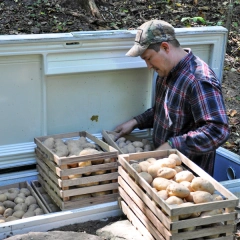Once the coop was designed and built we were on to thinking about the outdoor set-up for our new flock. Although free-range was appealing in terms of chicken nutrition/feed costs and quality of life, we were concerned about the many potential predators and also wanted more control over where (and on what) our chickens roamed. I was investigating different types of chicken runs when I learned about chicken tractors and discovered the pastured poultry methods developed by Joel Salatin of Polyface Farms. At first I was disheartened to think our coop design had been a big mistake and that we should have gone with something small and mobile. Then I heard Jack Spirko interview permaculturalist Paul Wheaton on the Survival Podcast and knew his paddock shift system was exactly what we were looking for. Paul’s article explains the idea in detail and gives an overview and comparison of other systems.
The basic idea is to create four or more fenced areas (or use portable fencing) and rotate the flock so that each area gets at least 28 days of rest before reuse . This allows the plant life to benefit from the grazing and fertilization and rebound becoming increasingly lush over time (intensive rotational grazing.)
Our paddock set-up has a permanent access run with four rotating paddocks. Each has some shade provided by nearby trees. So far it seems to be working well. We’ve been shifting the same day each week, which only gives 21 days of rest, so we probably need to adjust that for optimal results, it’s just harder to keep track of a 9/10-day rotation. It’s really nice to have fresh forage for them and to know they’re not going to be swiped up by a wandering neighbor dog.
One predator issue remains in the hawk we often see inspecting the yard. We’ve considered using netting or even strands of wire and have thought about some type of shelter item that could be moved from paddock to paddock. I would prefer to see some type of evergreen shrubbery or other tall plant (like the peony bushes growing along the access run where they like to hang out) rather that additional structures, but it would take time for most plants to be big enough to make much of a difference. Ideally we’d have all kinds of established trees and plants that provide additional food inputs incorporated into the design. One of our hens ended up being a rooster, and he’s been taking his watch-dog, protective role very seriously, so maybe that will make enough of a difference safety-wise.
 Anybody else trying
Anybody else trying a paddock shift system? Any hawk safety suggestions from the veteran chicken farmers out there?




